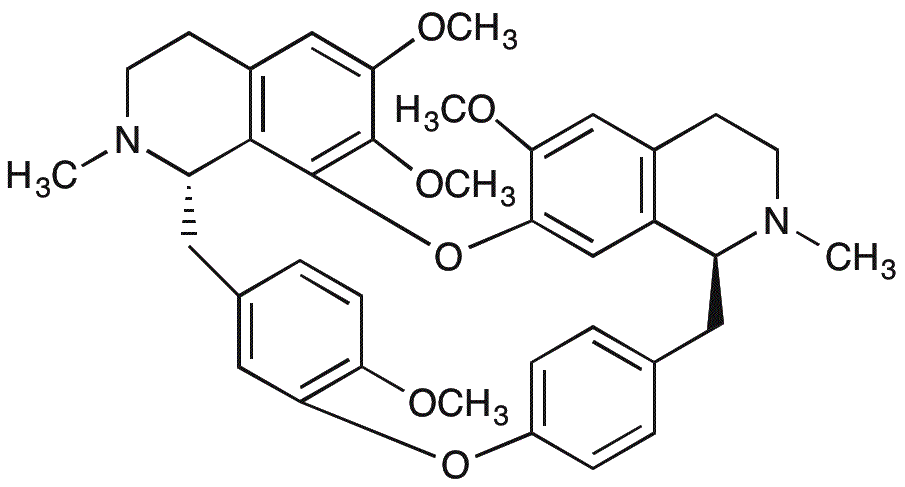Tetrandrine is widely utilized in research focused on:
- Cardiovascular Health: Tetrandrine has shown potential in managing hypertension and improving heart function. It acts as a calcium channel blocker, which can help in reducing blood pressure and preventing heart-related issues.
- Anti-inflammatory Applications: This compound is recognized for its anti-inflammatory properties, making it useful in treating conditions like arthritis. Researchers are exploring its role in reducing inflammation and pain in various inflammatory diseases.
- Anticancer Research: Tetrandrine is being studied for its ability to inhibit cancer cell growth. Its unique mechanism of action could provide new avenues for cancer treatment, particularly in overcoming drug resistance.
- Neuroprotective Effects: Emerging studies suggest that tetrandrine may have protective effects on neurons, making it a candidate for research into neurodegenerative diseases such as Alzheimer’s and Parkinson’s.
- Traditional Medicine: Tetrandrine has a long history of use in traditional Chinese medicine for various ailments. Its applications in herbal formulations highlight its relevance in alternative medicine and natural health products.
General Information
Properties
Safety and Regulations
Applications
Tetrandrine is widely utilized in research focused on:
- Cardiovascular Health: Tetrandrine has shown potential in managing hypertension and improving heart function. It acts as a calcium channel blocker, which can help in reducing blood pressure and preventing heart-related issues.
- Anti-inflammatory Applications: This compound is recognized for its anti-inflammatory properties, making it useful in treating conditions like arthritis. Researchers are exploring its role in reducing inflammation and pain in various inflammatory diseases.
- Anticancer Research: Tetrandrine is being studied for its ability to inhibit cancer cell growth. Its unique mechanism of action could provide new avenues for cancer treatment, particularly in overcoming drug resistance.
- Neuroprotective Effects: Emerging studies suggest that tetrandrine may have protective effects on neurons, making it a candidate for research into neurodegenerative diseases such as Alzheimer’s and Parkinson’s.
- Traditional Medicine: Tetrandrine has a long history of use in traditional Chinese medicine for various ailments. Its applications in herbal formulations highlight its relevance in alternative medicine and natural health products.
Documents
Safety Data Sheets (SDS)
The SDS provides comprehensive safety information on handling, storage, and disposal of the product.
Product Specification (PS)
The PS provides a comprehensive breakdown of the product’s properties, including chemical composition, physical state, purity, and storage requirements. It also details acceptable quality ranges and the product's intended applications.
Certificates of Analysis (COA)
Search for Certificates of Analysis (COA) by entering the products Lot Number. Lot and Batch Numbers can be found on a product’s label following the words ‘Lot’ or ‘Batch’.
Numéro de catalogue
Numéro de lot/série
Certificates Of Origin (COO)
This COO confirms the country where the product was manufactured, and also details the materials and components used in it and whether it is derived from natural, synthetic, or other specific sources. This certificate may be required for customs, trade, and regulatory compliance.
Numéro de catalogue
Numéro de lot/série
Safety Data Sheets (SDS)
The SDS provides comprehensive safety information on handling, storage, and disposal of the product.
DownloadProduct Specification (PS)
The PS provides a comprehensive breakdown of the product’s properties, including chemical composition, physical state, purity, and storage requirements. It also details acceptable quality ranges and the product's intended applications.
DownloadCertificates of Analysis (COA)
Search for Certificates of Analysis (COA) by entering the products Lot Number. Lot and Batch Numbers can be found on a product’s label following the words ‘Lot’ or ‘Batch’.
Numéro de catalogue
Numéro de lot/série
Certificates Of Origin (COO)
This COO confirms the country where the product was manufactured, and also details the materials and components used in it and whether it is derived from natural, synthetic, or other specific sources. This certificate may be required for customs, trade, and regulatory compliance.


